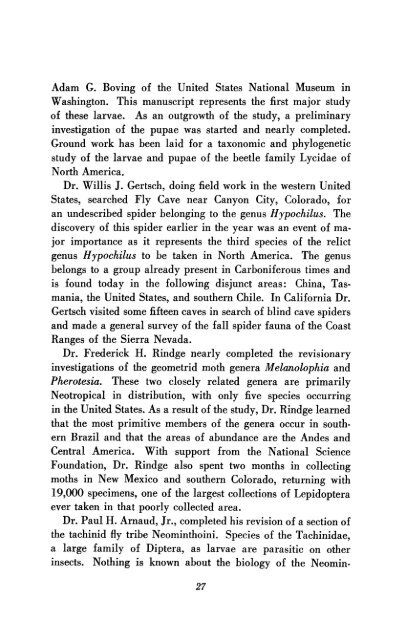1961-1962 - American Museum of Natural History
1961-1962 - American Museum of Natural History
1961-1962 - American Museum of Natural History
Create successful ePaper yourself
Turn your PDF publications into a flip-book with our unique Google optimized e-Paper software.
Adam G. Boving <strong>of</strong> the United States National <strong>Museum</strong> in<br />
Washington. This manuscript represents the first major study<br />
<strong>of</strong> these larvae. As an outgrowth <strong>of</strong> the study, a preliminary<br />
investigation <strong>of</strong> the pupae was started and nearly completed.<br />
Ground work has been laid for a taxonomic and phylogenetic<br />
study <strong>of</strong> the larvae and pupae <strong>of</strong> the beetle family Lycidae <strong>of</strong><br />
North America.<br />
Dr. Willis J. Gertsch, doing field work in the western United<br />
States, searched Fly Cave near Canyon City, Colorado, for<br />
an undescribed spider belonging to the genus Hypochilus. The<br />
discovery <strong>of</strong> this spider earlier in the year was an event <strong>of</strong> major<br />
importance as it represents the third species <strong>of</strong> the relict<br />
genus Hypochilus to be taken in North America. The genus<br />
belongs to a group already present in Carboniferous times and<br />
is found today in the following disjunct areas: China, Tasmania,<br />
the United States, and southern Chile. In California Dr.<br />
Gertsch visited some fifteen caves in search <strong>of</strong> blind cave spiders<br />
and made a general survey <strong>of</strong> the fall spider fauna <strong>of</strong> the Coast<br />
Ranges <strong>of</strong> the Sierra Nevada.<br />
Dr. Frederick H. Rindge nearly completed the revisionary<br />
investigations <strong>of</strong> the geometrid moth genera Melanolophia and<br />
Pherotesia. These two closely related genera are primarily<br />
Neotropical in distribution, with only five species occurring<br />
in the United States. As a result <strong>of</strong> the study, Dr. Rindge learned<br />
that the most primitive members <strong>of</strong> the genera occur in southern<br />
Brazil and that the areas <strong>of</strong> abundance are the Andes and<br />
Central America. With support from the National Science<br />
Foundation, Dr. Rindge also spent two months in collecting<br />
moths in New Mexico and southern Colorado, returning with<br />
19,000 specimens, one <strong>of</strong> the largest collections <strong>of</strong> Lepidoptera<br />
ever taken in that poorly collected area.<br />
Dr. Paul H. Arnaud, Jr., completed his revision <strong>of</strong> a section <strong>of</strong><br />
the tachinid fly tribe Neominthoini. Species <strong>of</strong> the Tachinidae,<br />
a large family <strong>of</strong> Diptera, as larvae are parasitic on other<br />
insects. Nothing is known about the biology <strong>of</strong> the Neomin.<br />
27

















